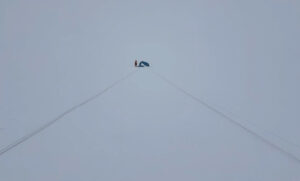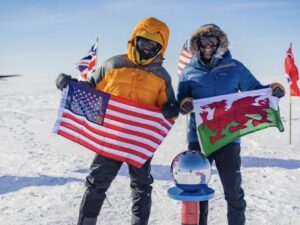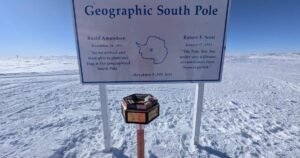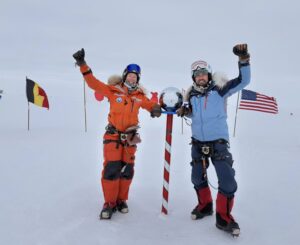Veteran Belgian adventurer Dixie Dansercoer’s many long-haul polar expeditions include the first North-to-South crossing of Antarctica in 1998. Together with fellow Belgian Alain Hubert, the pair manhauled and kite-skied 3,924km in 99 days. Dansercoer and Hubert also made the first crossing of the Arctic Ocean from Siberia to Greenland in 2007. He has climbed Cho Oyu, completed a couple of Ironmans, placed highly in a number of ultramarathons and spent years guiding in the polar regions.
Despite the thinning ice the Arctic Ocean, logistical conundrums and miles on his own clock, the lure of arduous journeys isn’t over for Dansercoer and Hubert just yet.

Dansercoer and Troy Henkels during an attempt to do a double crossing of the Bering Strait. Photo: Dixie Dansercoer
In April, 2019, the Belgian duo plan to be dropped off at the North Pole, then ski, kite and paddle the 1,000km back to Cape Arkticheskiy, at the northern tip of Russia. A return journey to land in this direction hasn’t been done before. “The trans-Arctic drift is against us. But why not?” says Dansercoer.
The journey will become hardest near the Russian coast, where they’re likely to encounter large sections of open water. They plan to take 65 days of food, which includes a 10-day reserve. They estimate that their sled weights will be a reasonable 130kg each. The kite-skiing part has become something of a signature for Dansercoer’s polar journeys.
With all of the funding in place, Dansercoer and Hubert will spend the next few months fine-tuning their equipment and finalizing the exact finish point. Currently, Hubert is down in Antarctica managing the Princess Elisabeth Station, while Dansercoer is also heading south for his busy guiding season, which includes Antarctica, Norway, Switzerland, Lake Baikal and Spitzbergen.
ExWeb caught up with Dixie Dansercoer to find out more about this latest project.
ExWeb: What has led you to do another long Arctic journey?
My favourite places are the North Pole, the Arctic Ocean and the surrounding arctic coastlines. You have to become a bit of an animal and use your instinct to navigate, to pick the shortest route, to sniff when there’s danger. You have to know where the polar bears are and know when storms bring in the danger of ice cracking open. All of these things put you on edge. In the Antarctic, you have none of that. On the beauty level I see the Arctic Ocean as much more dynamic, colourful, full of life.
I really hope we’ll be able to do the North Pole to Arkticheskiy, but we’ll see how it goes with the counter currents. Anything is possible, but that does not mean that we guarantee success.

Reaching Greenland after sledding 2,000km from Siberia via the North Pole. Photo: Dixie Dansercoer
ExWeb: Why finish at Cape Arkticheskiy?
After five years of preparation, it’s gone from yep for sure, Franz Josef Land, oooh not so easy [due to visa/logistical issues], maybe we should divert to Svalbard. But a little voice told me that you really need to be true to your own mantra of going to places where there’s still a high unknown factor. So at this moment, after consultation with Victor Boyarsky, it will probably be Cape Arkticheskiy, a little south of Franz Josef Land.

Dansercoer still has enthusiasm for travel on the Arctic Ocean. Photo: Dixie Dansercoer
ExWeb: How will you deal deal with the open water in the final section of the journey?
We have a trimaran sled. We pull 90 percent of the time, but for those big expanses of open water at the end, we want to avoid having two frail sleds beside one another. That platform [which they used on previous North Pole trips] has too much drag. And so with one sled in front of the other, plus two outrigger arms linked to flotation devices, we have a nice rowing setup. We row with lightweight Kevlar oars. In tests, we can go at a good speed. We’ll sit on a lightweight, foldable sort of camp seat to give the back a bit of a rest. It’s like a real rowboat.

Testing the trimaran. The two sleds clip together and skis are attached to inflatable outriggers, which stabilizes the boat. Users can then row and even erect a lightweight sail. Photo: Dixie Dansercoer
We also have lightweight drysuits. The company I developed the suit with, Mullion/Ursuit, have come up with a very streamlined design. When you put it in a small package, it’s like two loaves of bread and weighs just over a kilo. Even more importantly, it fits the body more tightly, so less air gets into the suit. A lot of air makes it harder to swim. We also have more visibility around our heads, so we see better.
https://www.youtube.com/watch?time_continue=33&v=byU1dqRyMbA
ExWeb: Tell us more about your kite-skiing plans.
Even though kiting is pretty dangerous on the Arctic Ocean, with the compression zones and open water, it is still feasible. In low winds, it helps cancel out the weight of the sled. I’m fine tuning all parts of the kites and working with Ozone to get everything hyper-lightweight. So the novelty is light, single-skin kites, and instead of having them in the air 25m away, I’ve got them much closer — only 5m. I’ve also brought down the weight of the bar and the security and safety systems. So we’re really into minimalist gear. I’ve done enough snow kiting on the Arctic Ocean and I’ve spent way too much time untangling kites that have just landed behind the compression zones or tangled up in sastrugi. So we need to prevent those situations by having the kite much closer so that will not happen. We all know there is more wind higher up, but that’s a disadvantage that we’ll have to accept. But if we see a large section of flat ice, we can still add lines and have the kites fly higher.

Dansercoer kiting during the first circumnavigation of the Greenland icecap in 2014. Photo: Eric McNair-Landry
ExWeb: Any other equipment innovations?
The last thing that I’ve developed is edible packaging for the food, in cooperation with the United States Department of Agriculture and students from a hotel school in Leuven, here in Belgium. We’re doing our best to get it ready in time. We’ve come up with this idea of no waste, no time to waste!
ExWeb: How much negative drift do you expect, since the current is against you?
You never know, because it depends on weather. The biggest negative drift is when a storm comes in and pushes all that ice. Then the freight train of drift begins. When the storm ends, the drift takes another day or so to stop. Under the ice, you also have ocean currents, and that’s where the Trans-Arctic drift comes in. It starts at the Siberian coast and then hits the Pole. East of the Pole, it takes you down to the northeast coast of Greenland. How big is that, how strong? Don’t know. It’s hard to find a solid answer because there are no averages.

Arctic Ocean currents shown by the drift of buoys released at the North Pole. Photo: Supplied by Dixie Dansercoer
It was much easier when we did our Trans-Arctic trip in 2007 from Arkticheskiy to the Pole and then to Greenland. We benefited most of the time from positive drift. That’s why it’s smarter to leave Arkticheskiy and head north to the Pole and on to Canada. But the logistics that once made that possible is over. Very few people will dare to go either to Greenland or Canada because of the problems with pickup in case of emergency.

A compression zone on the Arctic Ocean. Photo: Dixie Dansercoer
ExWeb: Any other thoughts on the way ahead for you both?
I think we have the advantage of having lived, and we know what’s ahead. The pulling is hard, and it’s all about putting in the hours. Fortunately, we leave in April and will have 24-hour daylight. You can decide whether you want to put in 10, 12 hours or more. Those who attempt a full Arctic Ocean traverse start with four to five hours of daylight, and that’s a whole different story with a heavy sled, if you want to do it unsupported.






